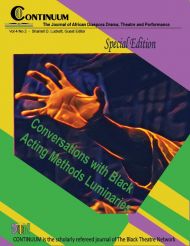The Movement by Kathy D. Harrison
Directed by Kathy D. Harrison
|Diversity Youth Theatre. National Black Theatre Festival, Salem College.
Friday, August 7, 2015 at 3pm
Imagine a time where there were no arrests for the eighteen bombings in seven years. Imagine a Civil Rights leader chain-whipped because he attempted to enroll his child in an all white school. Imagine a car of young black men driving from an underground civil rights meeting. They are stopped and almost beaten to death by the police. Imagine the fear of a black person’s life emanating at every turn. Because of the many recent incidents in this nation, it is not hard to imagine. However in 1963, there were no cell phones to record horrific everyday events to send to the press. The idea of a black person as president was only a dream. Martin Luther King, Jr. was serving time in the Birmingham Jail, hitting a low point in the movement. Led by Reverend James Bevel, The Children’s March in Birmingham in 1963 rejuvenated the movement to a transformative place in history. Kathy D. Harrison, Founder/Artistic Director of the Diversity Youth Theatre ( DYT), wrote and directed a powerful a cappella musical that encapsulated the children’s struggle for equal rights in Birmingham, Alabama. The DYT’s performance at the National Black Theatre Festival between August 7-8, 2015 reminded us of this powerful story of triumph.
As the lights rise, the performers are in the center of the stage singing, “ This is our Story”. While singing, each actor selectively transforms into Angela Davis, Ruby Bridges, Harriet Tubman, Frederick Douglas, and Rosa Parks and other important African-Americans in history. With crisp transitions into characters, I was spellbound. The harmonious lyrics, “It is important that we, learn, share, and hear our stories/African-American Stories /So we going to tell it”swelled throughout the theatre. With Harrison leading the song all the way down to the youngest performer, Nigel Williams (primary school), the performers captivated the audience as they laid the foundation and drew us into their world.
As the play moved along, The songs “Birmingham 1963” and “Segregated” continued to illuminate for us the bleak reality of the black people of Birmingham. Listening to the radio was a great outlet for the youth. They danced the popular dances and played the popular music. Through this pastime, the famous radio disc jockey of Birmingham, Shelley “ The Playboy” Stewart used his influence to connect to them. “ He talked that jive talk”. He used coded messages to send messages about future meetings of the March. As the play progressed to the end of Act One, excerpts of “Letters from a Birmingham Jail” were eloquently performed. Even though I was aware of this history, the performance made me wait in anticipation of what would happen next.
A blue light permeated the stage in Act two as they sang, “ Right Now”. The actors beautifully illuminated the rigorous training the young people endured to prepare for the March. They were taught non-violent behavior while instinctively some students wanted to respond with “ An Eye for an Eye” approach. Lawrence Dandridge, who played James Bevel and Tobias,was such a phenomenal performer. The transitions to each character were sharp and clear. His physicality for each character was believable and a sharp contrast from each other.
The play ended as it began with the song, “This Is Our Story“. One of the final speeches still resonates within me: “Liberty and Justice for all. What does that mean to you? And I’m American too. You don't need to have the courage to march. All you have to believe is that there has to be a better way.” Though it is based in a historical event, this play resonates with a message we need today. Through America’s current racial turmoil, will the young people of today stand up like the young people of 1963 to make a remarkable difference in history? Harrison gives us that hope.
Billicia Hines
Director of the Black Theatre Program, Assistant Professor, Wayne State University



